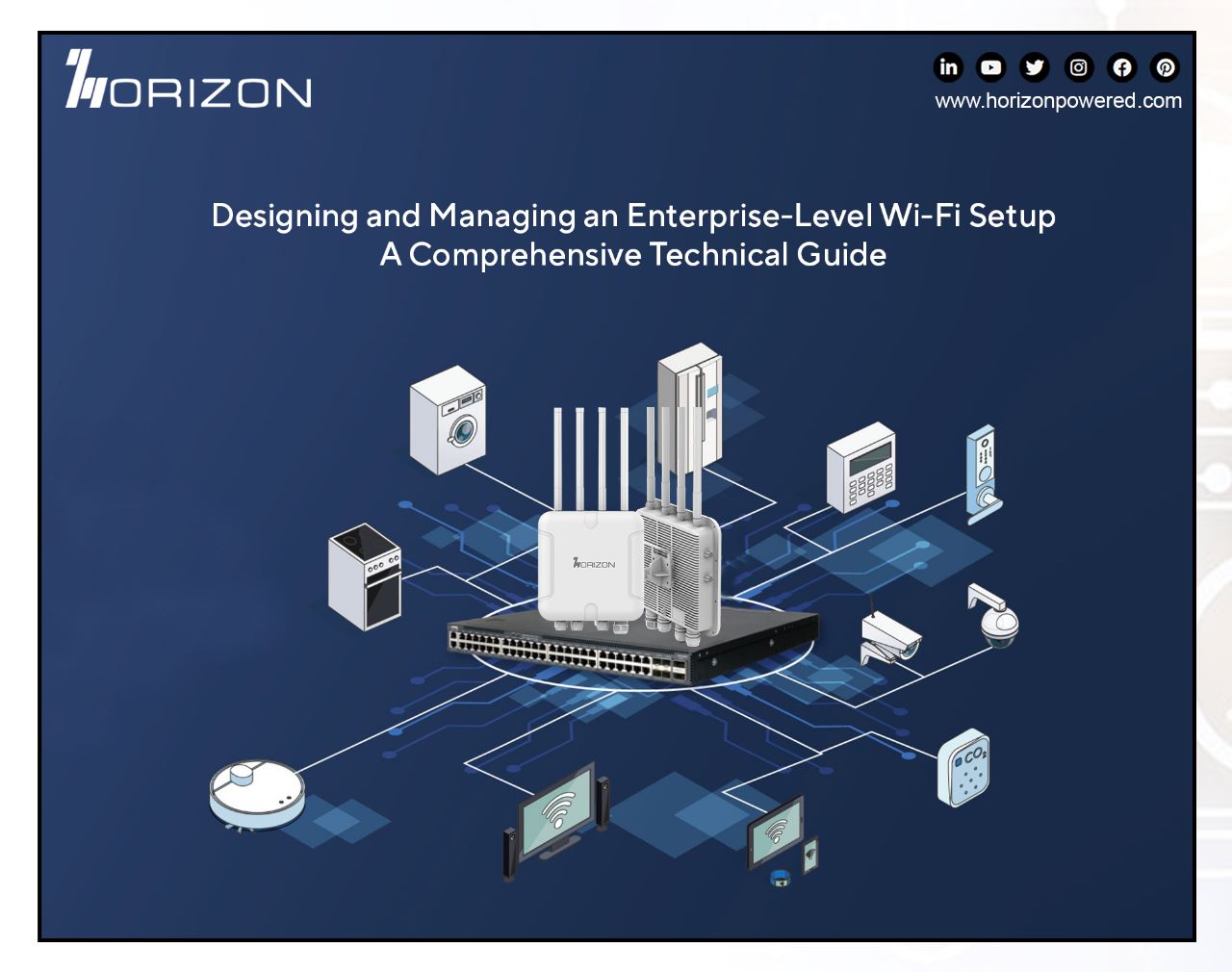
Designing and Managing an Enterprise Wi-Fi Setup: A Comprehensive Technical Guide
In today’s digitally-driven business landscape, a robust and high-performing Wi-Fi network is crucial for enterprises of all sizes. A well-designed and effectively managed enterprise Wi-Fi setup ensures seamless connectivity, supports a large number of users, and enhances productivity. This comprehensive guide dives deep into the technical aspects of setting up and managing an enterprise Wi-Fi network, covering key considerations, methodologies, best practices and how Horizon Powered manufactured devices can help achieve superior Network at an affordable price.
Defining Enterprise Wi-Fi Requirements:
Defining your organization’s requirements is the foundational step in building an enterprise Wi-Fi setup. Start by evaluating the geographical location, number of concurrent users who will be accessing the network. Consider both employees and guests. Additionally, assess the coverage area, building layout, and any unique environmental or industry-specific needs. Understanding these requirements will drive subsequent design decisions.
To ensure accurate requirement gathering, Horizon Powered’s team conducts interviews with key stakeholders and department representatives. We work hand in hand with onsite IT personnel and network administrators who provide insights into the existing infrastructure and anticipate their growth as well as conduct on site Horizon’s device testing. We involve different stakeholders; It helps us capture a comprehensive view of the Wi-Fi network needs.
Performing a Site Survey:
Evaluating your existing network infrastructure is key to ensure that it can handle the demands of the Wi-Fi setup. Assess the capacity and capability of switches, routers, and firewalls to support increased network traffic. Determine if any upgrades or additional equipment, such as Gigabit Ethernet switches or Power over Ethernet (PoE) switches, are necessary to provide ample connectivity and power to the Aps or a fixed wireless will be a better solution.
To perform a site survey, you should use professional tools that provide heatmaps and signal strength measurements. These tools help us identify areas with weak signal coverage, interference hotspots, or potential dead zones. By analyzing the survey results, we can determine the optimal placement and number of access points (APs) required to ensure adequate coverage and signal quality throughout your organization.
Network Infrastructure Evaluation:
A thorough site survey is critical for gathering data about your organization’s physical environment. It helps identify potential challenges and opportunities for optimizing Wi-Fi coverage and signal strength. Factors to assess include building layout, construction materials, wall density, and interference sources like other wireless devices or neighboring networks.
It’s crucial to assess the capacity of the network backbone to handle the increased data flow resulting from the Wi-Fi network. Consider factors such as link speeds, available bandwidth, and the ability to support Quality of Service (QoS) policies. Upgrading network components may be necessary to support higher speeds, improved throughput, and efficient traffic management.
Designing Network Topology:
Based on the site survey results, develop a network topology plan that outlines the placement and configuration of Access points (Aps). Consider factors like coverage area, user density, and anticipated network traffic. The goal is to achieve optimal coverage and minimize interference for a seamless user experience.
To optimize network topology, focus on strategic AP placement. Avoid overcrowding APs in a single area, as it can lead to interference and reduced performance. Distribute APs evenly to provide consistent coverage throughout the premises. It’s essential to consider both indoor and outdoor coverage requirements, especially for organizations with large campuses or outdoor work areas.
Horizon Powered’s team can help employ different channels and frequency bands (2.4 GHz Wi-Fi 5, 5.8 GHz Wi-Fi 6 or 6 GHz Wi-Fi 6E) to avoid congestion and optimize performance. Use tools to analyze nearby networks and select the least congested channels. Additionally, consider the deployment of multiple APs with overlapping coverage to facilitate seamless roaming for users.
Access Point Selection:
Choosing the right access points is crucial for an enterprise Wi-Fi setup. Look for APs with enterprise-grade features such as high data rates, multiple-input multiple-output (MIMO) technology, and beamforming for better signal propagation. These features enhance overall network performance and ensure reliable connectivity.
Consider Access Points with support for the latest Wi-Fi standards like 802.11ac or 802.11ax (Wi-Fi 6E) like Horizon’s AP600E to ensure compatibility with modern devices and future-proof your network. AP600E offer better coverage, increased capacity, and advanced security features.
Another important consideration is scalability. Choose Access Points that can be easily expanded or integrated into a centralized management system to accommodate future growth. This flexibility allows for seamless expansion as the organization’s Wi-Fi requirements evolve, Horizon AP600E is a very versatile offers the highest level of flexibility for your network.
Implementing Security Measures:
Security is of paramount importance when setting up an enterprise Wi-Fi network. Implementing robust security measures protects against unauthorized access and potential threats to your network and data. Our several key security considerations include:
- Strong Encryption: Implement encryption protocols such as WPA2 or WPA3 to secure data transmission over the wireless network. These encryption standards provide robust security against unauthorized access and ensure the confidentiality of data.
- Authentication Methods: Consider implementing 802.1X authentication for individual user credentials. This method requires users to provide unique login credentials to access the network, preventing unauthorized users from gaining access.
- Network Segmentation: Employ network segmentation using Virtual Local Area Networks (VLANs) to enhance security. Segmenting the network separates user groups or critical infrastructure components, reducing the attack surface and limiting the potential impact of security breaches.
- Intrusion Detection and Prevention Systems (IDPS): Deploy IDPS to monitor network traffic and identify potential security threats. IDPS can detect and alert administrators about suspicious activities, enabling timely response and mitigation.
- Guest Access: Implement a separate guest network that provides limited access to the internet while isolating it from the organization’s internal network. This approach ensures that guest users cannot access sensitive resources or compromise network security.
Horizon’s DMS or Device Management Server makes implementing all these security measures a walk in the park.
Quality of Service (QoS):
To prioritize critical applications and ensure a consistent user experience, configure Quality of Service (QoS) settings. QoS helps allocate network resources appropriately, giving priority to real-time applications like voice and video conferencing over less time-sensitive traffic. This ensures optimal performance and minimizes latency for critical business applications.
When configuring QoS, consider defining different traffic classes based on application types, service level agreements (SLAs), or port numbers. Assign appropriate priorities and bandwidth allocations to each traffic class to meet the specific requirements of your organization.
Network Management:
Centralized network management is crucial for effectively monitoring and controlling the Wi-Fi network. Deploy a robust network management system that allows for remote monitoring, configuration, and troubleshooting of APs. These systems provide a unified interface to manage multiple APs, set security policies, and generate reports on network performance.
Consider a cloud-based management solution like Horizon’s DMS or Device Management server for scalability and ease of access. DMS allows network administrators to monitor and manage the Wi-Fi network from any location, simplifying the process of provisioning, configuring, and troubleshooting the Access Points.
Horizon DMS provide real-time visibility into network performance, client connectivity, and security events. It also facilitates firmware updates, Access Point configuration changes, and troubleshooting through a centralized dashboard. Additionally, it provides analytics and reporting to gain insights into network usage, user behavior, and performance trends.

Testing and Optimization:
Once the Wi-Fi network is deployed, comprehensive testing is necessary to identify and address any coverage gaps, interference issues, or performance bottlenecks. Testing ensures that the network meets the defined requirements and provides a reliable and efficient user experience.
Horizon uses specialized tools to measure signal strength, throughput, latency, and packet loss in various areas of the premises. Conducting tests under different conditions, such as high user loads or peak times, to simulate real-world scenarios. We analyze the test results to identify areas of improvement and optimize network performance.
Fine-tune Access Point configurations, channel assignments, and transmit power levels based on the test results. This iterative process of testing and optimization ensures that the Wi-Fi network is optimized for the specific environment and user requirements.
Horizon Powered presents an excellent solution for designing and managing an enterprise-level Wi-Fi setup. With Horizon Powered undoubtedly you can have a reliable and efficient solution for managing an enterprise Wi-Fi setup, making it an ideal choice for organizations seeking to elevate their connectivity infrastructure.
Investing in Horizon Powered is a strategic decision that promises to propel businesses into a future of efficient and powerful wireless networking, equipping them to meet the ever-evolving demands of the digital age.







